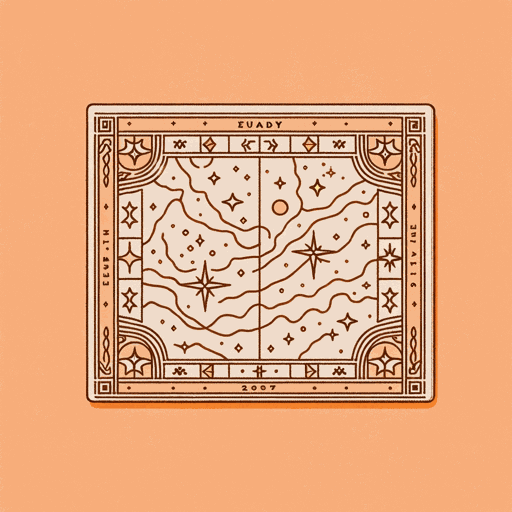45 pages • 1 hour read
Jennifer Zeynab JoukhadarThe Map of Salt and Stars
Fiction | Novel | Adult | Published in 2018A modern alternative to SparkNotes and CliffsNotes, SuperSummary offers high-quality Study Guides with detailed chapter summaries and analysis of major themes, characters, and more.
Summary and Study Guide
Overview
Zeyn Joukhadar is a transgender Syrian American writer (also published under the name Jennifer Zeynab Joukhadar). His first novel, The Map of Salt and Stars (2018), won the 2018 Middle East Book Award in Youth Literature and became a 2018 Goodreads Choice Awards Finalist in Historical Fiction. Comprising two interwoven narratives, the novel follows Nour, the present-day protagonist whose flight from a war-torn Syria parallels the journey of her imaginary heroine—Rawiya, a medieval mapmaker’s apprentice. In Nour’s more contemporary narrative, the portrayed Syrian conflict is based on the real crisis that began in 2011, and Nour’s traumatic experiences reflect those of Syrian refugees in their compelled exodus. As a coming-of-age story, the novel centers themes of subverted gender roles, self-discovery, and the meaning of home.
Plot Summary
The Map of Salt and Stars begins with Nour moving to Homs, Syria, from Manhattan with her mother and two older sisters after the death of her beloved father. Nour, who speaks faltering Arabic and has synesthesia (a neurological phenomenon causing the perception of sounds to simultaneously evoke color perception, or vice versa), decides to tell the story of Rawiya to the fig tree at the Homs house. The story is one that her father told her before he died. Nour carries Rawiya’s story with her when the bombing begins in Syria and her family are forced to flee their home. From this moment in the narrative, Rawiya’s journey parallels Nour’s as the two heroines traverse the same territory, though their stories take place hundreds of years apart.
Rawiya is a 12th-century character from Ceuta, the African part of Spain. She is the daughter of a poor widow, disguising herself as a boy so that she can seek adventure and apprentice with the mapmaker al-Idrisi. Rawiya and al-Idrisi go to Palermo, Sicily, where King Roger II challenges them to make the most accurate possible map of the known world. They head back to the Middle East to begin work. On the way, they encounter the poet Khaldun. An emir has sentenced Khaldun to death if he does not kill the roc—a terrifying, enormous bird. When Rawiya cleverly uses her father’s sling to strike and dislodge one of the roc’s eyes, the bird vows deadly revenge. Meanwhile, Rawiya, still disguised as a boy, falls in love with Khaldun and reveals her feminine identity to him—and he returns her love. In a decisive battle, Rawiya defeats the roc. During the battle, however, al-Idrisi also learns of Rawiya’s true identity. At first he feels betrayed, but then he accepts her wholeheartedly. They complete King Roger’s map, but when King Roger dies, the map and all of his books are threatened with destruction by noblemen who want to usurp his successor. Khaldun almost dies in battle, and the manuscript is nearly destroyed. However, at the end of the novel, Khaldun, Rawiya, and al-Idrisi return to Ceuta. There, Rawiya marries Khaldun and reunites joyfully with her mother.
Guided by a map that her cartographer mother paints in acrylics, Nour also follows Rawiya’s journey—traveling from Syria, through Jordan, Egypt, Libya, Algeria, and Morocco, before arriving in Ceuta. At the beginning of her journey, Nour becomes close with Abu Sayeed, her father’s adopted brother, who tells her about rocks and the history of the places they traverse. The family also meet Umm Yusuf’s family, which includes a mother, grandmother, a little girl, and a teenage son Yusuf with whom Nour’s sister Zahra falls in love. The travelers must continually flee westwards as bombing and violence threaten their lives. After there is an attempted rape of Nour’s sister Huda, Nour’s mother shaves Nour’s head to disguise her as a boy and protect her from the same threat. Nour struggles to maintain hope after witnessing her sister’s assault, and then she loses Abu-Sayeed to drowning.
When Huda’s injured arm worsens, her mother seeks a hospital. She charges Zahra and Nour with using her painted map to travel westwards to Ceuta and find their father’s brother, Uncle Ma’mun. On their way, the girls navigate another perilous sea-journey, a violent people-smuggling operation, a camel-led trek across the Algerian and Moroccan desert with Amazigh nomads, and finally, a journey in a freezing-cold fruit truck. At Ceuta, they are held in a refugee camp, before following the map to Uncle Ma’mun’s house. There, their mother and Huda are waiting for them as well as Yusuf and his family. Nour decides that home is wherever her family is.
Featured Collections
Action & Adventure
View Collection
American Literature
View Collection
Books that Feature the Theme of...
View Collection
Coming-of-Age Journeys
View Collection
Grief
View Collection
Immigrants & Refugees
View Collection
Memorial Day Reads
View Collection
Middle Eastern Literature
View Collection
Military Reads
View Collection

